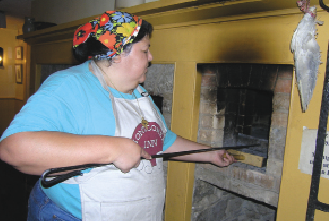
Blast from the past
February 18, 2009
By
Brian Hartz
When the Canadian Pastry Chefs Guild gathered for their November
meeting at Montgomery’s Inn in Etobicoke, they got a taste of what
bread making was like more than 175 years ago.
The traditional bake oven at Toronto’s historic Montgomery’s Inn has been given new life

|
|
| The huge fireplace that provides heat for the traditional bake oven at Montgomery’s Inn.
|
When the Canadian Pastry Chefs Guild gathered for their November meeting at Montgomery’s Inn in Etobicoke, they got a taste of what bread making was like more than 175 years ago.
It was a simpler time, to be sure, with no electricity or running water – amenities we take for granted these days when preparing food. Bread was baked in brick hearths set deep into walls next to a roaring fireplace, using grain harvested from the surrounding fields. The telegraph had not yet been invented, the age of the railroad was in its infancy, and Charles Darwin was about to change the world.
The inn was built by Thomas Montgomery, an Irish immigrant who worked
in the salt trade and as a surveyor. Born in 1790, he came to Canada
when he was 25 years old and, in 1829, married fellow Irish immigrant
Margaret Dawson. They had seven children but only two of them, sons
William and Robert, survived into adulthood.
Built of rubble stone in the Loyalist or Georgian style, the inn was a
major part of the village of Mimico, which later became known as
Islington, on west Dundas Street. With a tavern, formal dining room,
meeting rooms and an abundance of beds for weary travellers,
Montgomery’s Inn attracted a steady stream of locals and visitors.
Today the inn is a museum that preserves and showcases the history of
Islington Village. A few of its lower rooms have been modernized for
use as venues for business meetings, holiday parties, wedding
receptions and other social functions, to help cover the costs of
operating the building, but the main and second floors are a full-scale
time capsule of what life would have been like for the Montgomery
family and their guests.
Food services co-ordinator Sue Pye and a team of volunteers restored
the inn’s traditional stone bread oven last year, and now that cold
weather has arrived, they are baking bread on a regular basis and
selling it to raise funds to support the inn.
“It’s just too hot to bake bread here in the summer,” Pye says. “But
now is the perfect time because the heat from the fireplace helps warm
the building.”
She says the oven was first restored in the 1950s; however, the wrong
type of brick was installed, and it went unused for decades.
“Bits of bricks would fall on the bread while it was baking,” Pye says
of the previous restoration. “An old wooden door was put on the oven
and it was ignored until 2005, when some volunteers at the inn
suggested we rebuild the bake oven. With the help of volunteers, the
community and the City of Toronto, just over two years later we had a
fully restored, fully functional and gorgeous historical bake oven.”

|
|
| Volunteer Vie Cardella talks to the Canadian Pastry Chefs Guild about how the Montgomery’s Inn traditional bake oven works.
|
|
 |
|
| Volunteer Vie Cardella prepares the bake oven for a batch of cookies.
|
The fundraising efforts began with an initial donation of more than $500 from the inn’s corps of volunteers. (Montgomery’s Inn functions in part thanks to the efforts of a large group of volunteers.) Additional support to this grassroots fundraising campaign came from bread sales, with help from Sunglow Bakery; volunteer bake sales; silent auctions; Christmas basket raffles, and ornament and fruitcake sales. All items were baked or supported by volunteers.
By the summer of 2007 Clifford Restoration and ERA Architects were working on the restoration, which they completed in October.
“There was a considerable learning curve to using the bake oven,” Pye says. “We were aided by wonderful training from volunteers who work at Dufferin Grove, Fort York and Campbell House. But before we could bake, the oven required a month-long curing process and then a slow break-in period, which meant starting small fires and building up the heat to the point of firing it for a full four hours.
“After that, we began experimenting with the duration of fires, consecutive firing, how it reacts and responds, how long it retains heat, where the hot spots might be, what type of fire to building (high vs. wide), how long you can hold your arm in the oven to gauge the heat (that’s the historic way), how things bake in a pan vs. without a pan, etc., etc.
“Along the way, there were many unbaked breads and biscuits, over-baked breads and biscuits, fire alarms and, finally, success. In the end it required lots of practice and patience, but the whole process was fun and rewarding – with some outstanding baked goods.”
Montgomery’s Inn now incorporates the bake oven into its regular events and activities. “It has a historical role – our historic cooking demos and for use in the George Brown College Food History course,” Pye says, “and a modern role – incorporating it into the daily life of the tea room and our special community events. We have lots of opportunities and we welcome anyone who would like to learn or experience this wonderful historic baking tool.” / BJ
For more information, contact Sue Pye at 416-394-8120 or spye@toronto.ca, or visit www.montgomerysinn.com.
Print this page
Leave a Reply